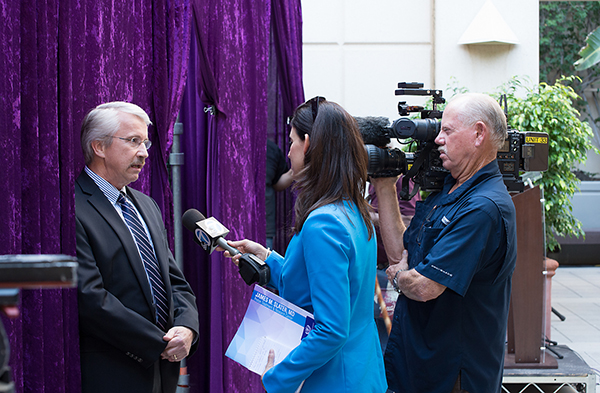Hundreds of former cancer patients and family members reunited Oct. 26 at Loma Linda University Medical Center to celebrate their health and the trailblazing proton radiation technology that helped them beat the disease. The reunion was part of the 25th anniversary of the James M. Slater, MD Proton Treatment & Research Center, the world’s first hospital-based proton therapy facility.
Former patients had many opportunities to come together over a two-day period of activities and reflect about the Proton Treatment Center, which for many became their home away from home during treatment. From the patient reunion dinner that launched the celebration to hikes, tours, seminars, healthy food demonstrations, a history wall unveiling, and a film screening, there were ample opportunities to share stories and common bonds.
The highlight of the 25th anniversary celebration was the proton homecoming event in which former patients gathered to pay tribute to one of the center’s most celebrated staff members, Lynn Martell, DMin, director of special services. Martell works with patients every step of the way during their treatment — from the orientation he provides when they begin treatment, through the many wellness and spiritual programs that help them feel whole again.
“We are extremely proud of our program. Not only were we the first to bring this lifesaving technology to the hospital setting, but there is no other proton center worldwide that devotes the attention we do to other aspects of the healing process,” said Jerry Slater, MD, chair and medical director of the LLU department of radiation medicine and the James M. Slater, MD Proton Treatment & Research Center.
“In addition to targeted proton treatment, we concentrate on patient-wellness elements including nutrition, activity and spirituality, all which have proven to be vital to healing and longevity.”
Loma Linda’s philosophy of care begins at the time of diagnosis and centers around treating the “whole person,” including the myriad of physical, psychological and spiritual needs that are essential to healing. Every aspect of healthy living is presented to LLU Medical Center patients as they learn that healing comprises many components, from nutrition to physical activity to social networking to spiritual support.
The 25th anniversary series of events included the official unveiling of the Proton History Wall, which showcases the long and illustrious journey and accomplishments of the center. In addition to the actual development of proton technology for cancer treatment in the hospital setting, some of the many milestones featured on the wall include the center’s work with NASA to research the effects of radiation in space; the development of a robotic precision patient alignment system, which further improves the accuracy of repeatable patient positioning; and countless clinical trials that continue to be conducted to improve and expand proton treatment’s effectiveness.
“The future of proton is incredibly promising thanks to technological advancements that will allow for the treatment of additional types of difficult-to-reach tumors while, at the same time, expanding proton’s effectiveness in the treatment of numerous other diseases and conditions,” Slater reported during the history wall unveiling ceremony.
According to Slater, the future of proton’s uses includes expanded treatment for pediatric tumors as well as treatments for gastrointestinal diseases including esophageal, lung and liver tumors. Proton also is being studied as a potential treatment for heart disease and post-traumatic stress disorder.
Modern medical practices, including the use of proton radiation therapy, have led to a growing population of cancer survivors in the country. Survivors now number over 14 million, or one in 25 Americans.
“A quarter century has seemed to pass in the blink of an eye, and we are proud of our accomplishments that have helped save thousands of lives,” Slater said. “We look forward to the next 25 years and helping more people live the lives they deserve.”

